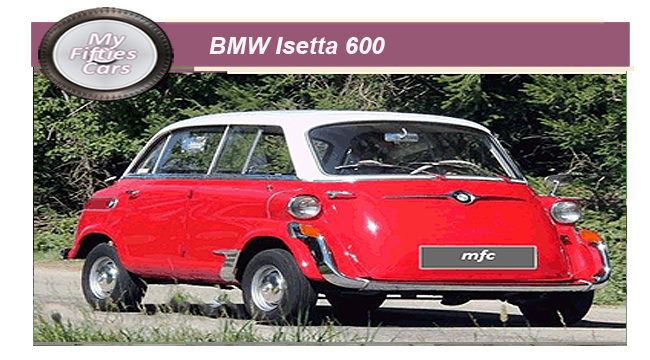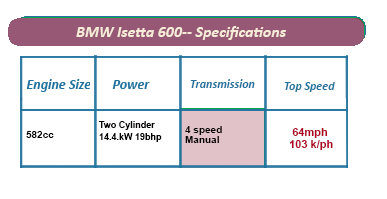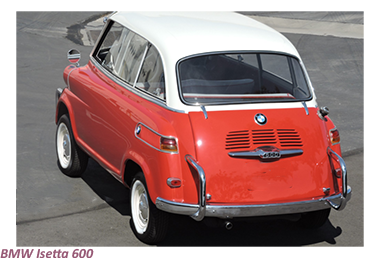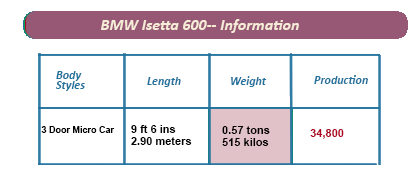
Having enjoyed considerable commercial success with their " bubble car," the Isetta, fitted with either a 250 cc or 300 cc engine, in 1957 BMW decided that the time was right to offer a four-seater version, which they called the Isetta 600.
T
 he 600 was brought in to fill the large gap between the micro-mini Isetta 250 and 300s and the 501 and 502 luxury saloons and coupes. Despite its squat appearance the Isetta 600 was surprisingly roomy.
he 600 was brought in to fill the large gap between the micro-mini Isetta 250 and 300s and the 501 and 502 luxury saloons and coupes. Despite its squat appearance the Isetta 600 was surprisingly roomy.
The front of the BMW 600 remained unchanged, although the body was stretched to contain the four seats, where both drivers and passengers could travel at the same levels of discomfort.

Power for this new generation “ super bubble” came from a 582 cc twin-cylinder engine, again drawn from the BMW motorcycle stable.
 Putting such a strong engine on what was still a small body meant that the 600 was reputedly capable of reaching a top speed of 103 km/h (64 mph), but probably not when filled with the maximum allowance of passengers.
Because of the 600's extended wheelbase, BMW fitted the car with a conventional as well as semi-trailing arm independent suspension installed on almost every new BMW model virtually to the end of the Twentieth century.
Putting such a strong engine on what was still a small body meant that the 600 was reputedly capable of reaching a top speed of 103 km/h (64 mph), but probably not when filled with the maximum allowance of passengers.
Because of the 600's extended wheelbase, BMW fitted the car with a conventional as well as semi-trailing arm independent suspension installed on almost every new BMW model virtually to the end of the Twentieth century.
![]()
 The myth that the Isettas were three-wheelers was finally dispelled entirely with the 600, whose two rear wheels were well apart, with only twelve inches between them, instead of the two inches on the 250 and 300 versions.
The myth that the Isettas were three-wheelers was finally dispelled entirely with the 600, whose two rear wheels were well apart, with only twelve inches between them, instead of the two inches on the 250 and 300 versions.
 Probably a little behind its time when introduced, the BMW 600 remained in production for just two years, selling a creditable 34,000 units during this period.
Probably a little behind its time when introduced, the BMW 600 remained in production for just two years, selling a creditable 34,000 units during this period.


